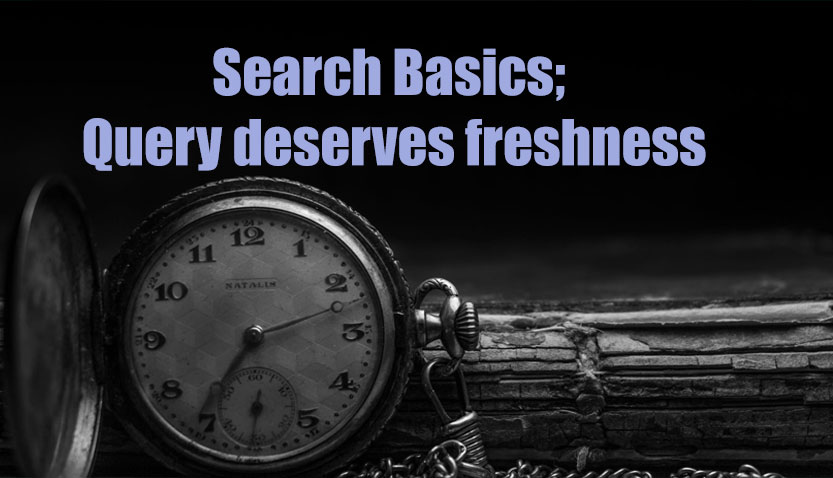Yea, it’s been a while hasn’t it? For those that might not be aware, or remember, QDF stands for; query deserves freshness. These days it seems the industry tends to be more interested in buzz-words such as RankBrain, Bert, EAT and more. Which are, interestingly enough, often fuzzy concepts that we can’t really optimize for, never mind getting our heads around.
In an effort to get back to basics, at least in terms of the information retrieval side of things, I recently wrote here about query classifications. Something we can actually get our heads around. Today, let’s go back in time a bit and look at some temporal factors that might be affecting how we do this ‘thing of ours’.

Temporal Factors in Search
So, what is the QDF? We first started hearing about it way back in 2011. It began with Google’s blog post; Giving you fresher, more recent search results.
Some of the elements noted include;
- Recent events or hot topics.
- Regularly recurring events
- Frequent updates.
Part of the issue that we can all identify with is that a newer piece of content isn’t going to have the equity (internal and external) that a more historically entrenched content item will have. Fortunately, via the QDF (and other approaches), Google understands the issue and has some algos in place to help minimize the issue.
We can go beyond that to more current approaches at Google such as RankBrain that largely deals with queries that Google’s not seen before. This can certainly be something that would potentially be at play for some of the elements of the QDF.
We want to consider that with each content strategy we should have one eye towards being able to react to ongoing market/industry changes for satisfy new content.
Under the Hood; what are temporal factors?
Over the years there’s been more than a few patents awarded to Google that might give us some insights into how they’re implementing these features (more on that later). One of the sets that we’ve looked at in the past was the historical ranking patents.
From these we know that some of the temporal factors can include;
- Document inception dates; attribution
- Document content updates/changes; how often a page changes
- Link-based criteria; (see below)
- Anchor text; has page focus changed?
- Traffic; CTR and historical traffic levels
- User behaviour; implicit and explicit feedback
- Ranking history
- Unique words, bigrams, and phrases in anchor text
- Linkage of independent peers
- Document topics
Historical link factors:
- The date of appearance/change of the link.
- The date of appearance/change of anchor text associated with the link.
- Date of appearance/change of the document containing the link.
- Trust of the document/site where the link resides.
- Freshness of the document.
- Document site authority.
Link velocity valuations:
- When links appear or disappear.
- The rate at which links appear or disappear over time.
- How many links appear or disappear during a given time period.
- Whether there is trend toward appearance of new links versus disappearance of existing links to the document, etc.
On the “freshness” side of things, they note a page can become “stale” when the following occurs;
- The date at which one or more links to a document disappear.
- The number of links that disappear in a given window of time.
- Some other time-varying decrease in the number of links (or links/updates to the documents containing such links).
By understanding this we can, by extension, better understand some factors that could come into play. This can apply to older and newer content to define what “fresh” might be algorithmically.
As such, it’s not always just about new pages when it comes to “freshness” because older pages can be adapted over time to keep up with the latest changes related to that topic. Don’t always reinvent the wheel.
Updating your content strategy
In order to ensure you’re better implementing these aspects into your content strategy we need to incorporate some of these concepts into our content strategy. Some areas that Google might be looking at could include;
- Blog/magazine content
- News
- Current events
- Evergreen updates based on trends
- Market/industry changes
- Effective use of social channels
You get the idea. In fact, I’d imagine that even the PAA (people also ask) could come into play which means trying to satisfy those with your temporal content strategy would be a good idea as well. Again, it’s not always about new content. It’s about new or trending queries that Google’s getting from the end user.
So there we have it.. if you’re not incorporating temporal approaches into your content strategy; don’t you think it’s time you did?
The patent Geeks
And of course what would a post of mine be without a little geeking to go with it? For those that want to go the extra mile, below are some patents that can help you get even deeper into the topic. And as always Bill (Slawski) did some interpretations of a good patent over on Go Fish with the freshness based ranking patent in 2015. https://gofishdigital.com/new-google-freshness-based-ranking-patent/
Newer Patents of interest;
- Identifying a primary version of a document
- Automatic discovery of new entities using graph reconciliation
- Systems and methods for improving the ranking of news articles
Older Patents of interest;
- Document scoring based on document inception date
- Document scoring based on document content update
- Document scoring based on query analysis
- Document scoring based on traffic associated with a document
- Document scoring based on link-based criteria
- FULL (includes all the above); Information retrieval based on historical data (filed December 2003, published March 2008)
And hey… here’s Matt Cutts back in the day on it;